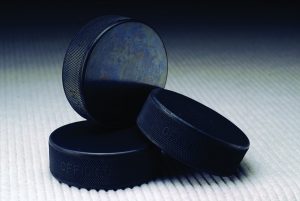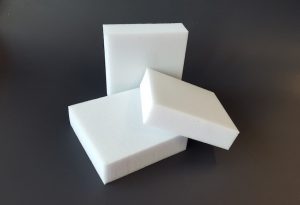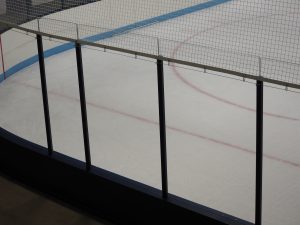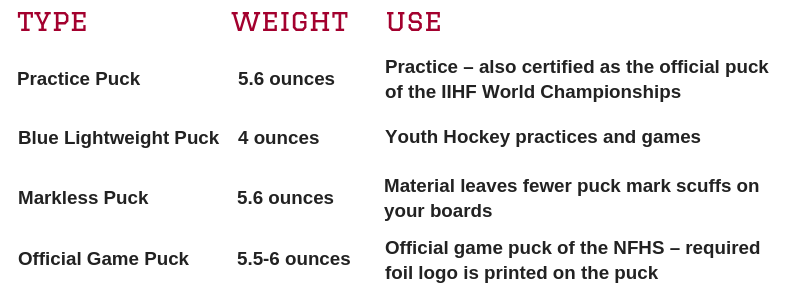 When it comes to managing your rink, pucks are probably the LAST thing on your mind. But all eyes are on the “biscuit” during the practices and games your rink hosts. Find out some history about the puck, learn some tips on cleaning those pesky puck marks, and discover the best way to keep pucks in the rink.
When it comes to managing your rink, pucks are probably the LAST thing on your mind. But all eyes are on the “biscuit” during the practices and games your rink hosts. Find out some history about the puck, learn some tips on cleaning those pesky puck marks, and discover the best way to keep pucks in the rink.
Although there are a lot of theories about how and where the modern game of ice hockey originated, one thing is certain – hockey pucks weren’t always solid rubber discs. In fact, pucks as we know them today were once crude, frozen cowpies which – when hit with sticks – glided effortlessly across a frozen pond. Throughout the history of the game, wood and stone were also commonly used. However, by the late 1800’s, rubber was the preferred material for the infamous puck and they were often crafted by slicing a lacrosse ball in thirds and using the middle.
 Today’s modern rubber puck is crafted for durability using 11 primary ingredients: natural rubber, a couple different oils, coal dust as a filler, antioxidants that lengthen the rubber’s lifespan and additives such as calcium carbonate and sulfur to cure the puck during the formation process.
Today’s modern rubber puck is crafted for durability using 11 primary ingredients: natural rubber, a couple different oils, coal dust as a filler, antioxidants that lengthen the rubber’s lifespan and additives such as calcium carbonate and sulfur to cure the puck during the formation process.
A Few Fun Facts!
- We know quite a bit about the evolution of the hockey puck but don’t know how it was referred to before introduction of the word “puck”. While “puck” was first recorded in the February 7th, 1876 edition of the Montreal Gazette, the word had already been widely circulating for decades.
- The average NHL game goes through a dozen or more pucks. The last NHL game during which only a single puck was used was in 1979 and that puck currently resides on display at the Hockey Hall of Fame.
- In 1996, Fox Television released smart pucks. Imbedded with a microchip which transmitted an infrared signal to computers which, in turn, superimposed blue and red halos around them for TV viewers, players were frustrated that these smart pucks behaved differently than traditional pucks on the ice…and they cost $15,000 each! Needless to say, they were quickly retired.
One puck does not fit all. Know which type of puck to purchase or recommend.
Removing puck marks can be no small task. These products can help you clean up your rink in no time.
PuckMark Erasers are a heavy duty pad that clean puck marks from the dasher board facing. Puck-Off Dasher Board Puck Mark Remover is an effective way to remove puck marks from the dasher facing but can also be used on other surfaces as a multi-purpose cleaning item. Team up the PuckMark Erasers with the Puck-Off for maximum clean!
are a heavy duty pad that clean puck marks from the dasher board facing. Puck-Off Dasher Board Puck Mark Remover is an effective way to remove puck marks from the dasher facing but can also be used on other surfaces as a multi-purpose cleaning item. Team up the PuckMark Erasers with the Puck-Off for maximum clean!
If you prefer power tools to elbow grease, you may prefer using the Cyclo Polisher – a fast and effective tool for removing puck marks and restoring shine to your scuffed dasher facing. Applying two coats of a sealer such as Exceed Board Sealer after you clean your boards will help to make future puck mark removal easier.
Installing puck control netting is an important step to keep patrons safe from flying pucks.

Although there is no requirement to have puck control netting installed at your rink, prioritizing spectator safety has become an industry standard. When determining what type of netting system would best suit your rink, consider the following:
- Importance of spectator view through netting
- Is the net system to be permanent or retractable/removable for other events?
- Ease of use
- Durability
- NHL Approval
- Cost
Spectator netting is available in nylon, monofilament or Kevlar material and can be purchased in either black or white. While the manner of installation depends on what type of building you have, installing the netting in a square rather than a diamond pattern provides easier installation and spectator viewing.
If you would like to learn more about the products we carry or are interested in ordering pucks, cleaning supplies or puck control netting for your hockey arena, we would love to connect with you! You can call us at 800-234-5522 or visit us online at www.beckerarena.com.

